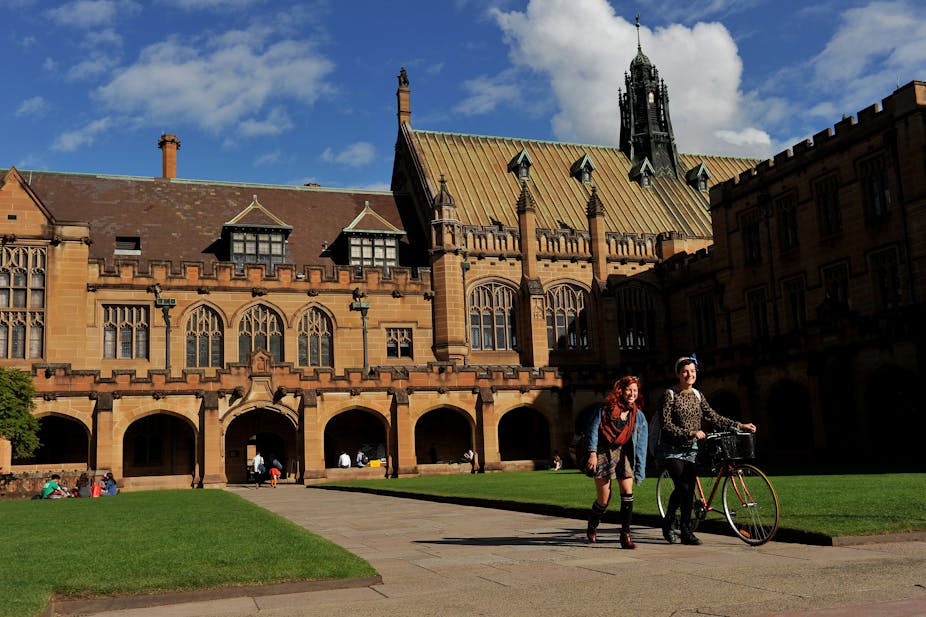There’s a devil lurking in the detail of the higher education reform bill presented to parliament. As expected, the bill, introduced yesterday, proposes to open Commonwealth subsidies for undergraduate teaching to private higher education providers. These will have access to 70% of the per-student rate that universities receive.
But commentators and universities seem to have missed one crucial aspect of the bill: if passed, any higher education provider “registered under the TEQSA (Tertiary Education Quality Standards Agency) Act in a category that allows the provider to use the word ‘university’” in its name will be able to access 100% of the Commonwealth subsidy. What that means is that the whole idea of a “public university” in Australia just disappeared.
If the bill passes, private universities and Australian campuses of overseas universities will have the same access to Commonwealth subsidies for undergraduate teaching as the present public universities have. This may not sound like much, but the ramifications are huge.
What defines an Australian university?
In Australia, the title “university” is protected by law. The title “university” is reserved for institutions offering a wide range of disciplines across all levels to PhD and with a broad research mission.
Being universities, these institutions are “self-accrediting”. This means that they have internal mechanisms (usually an academic board) that can monitor and maintain the quality of their course offerings.
Many other organisations (TAFEs, specialist colleges and the like) can offer higher education degrees, but these institutions cannot accredit their own courses. It is these organisations that will be able to receive the 70% subsidy per-student place.
Australia also has a small number of non-public universities. These are rather dully referred to as the “Table Bs” (Bond University, The University of Notre Dame Australia, MCD University of Divinity) and the “Table Cs” (Carnegie Mellon University and University College London, which have off-shoots in Australia). While these universities still need to meet TEQSA’s standards in order to operate in Australia, they have not been able to access the full suite of government grants, including, importantly, the Commonwealth Grant Scheme.
For these institutions, the trade-off has been the ability to charge whatever fees they wish. At the moment, you can go to any of the public universities offering Law and do an undergraduate degree for about $30,000. At Bond, the price for a law degree is $127,424.
What has historically differentiated a public university from a private one is that the public universities must focus their service on the nation and its citizens. These universities provide a “public good”, which is recognised in part through the provision of public funding. Other universities have been able to access limited public funding for research and infrastructure (the Table Bs), but this has generally been justified, at least implicitly, by appeals to public good.
So what’s at stake?
If the bill as currently drafted passes the Senate, any institution allowed to call itself a university in Australia will able to access the Commonwealth Grant Scheme.
So, what institution is allowed to call itself a university? The Provider Standards recognise our existing universities (public, private and overseas) as universities. They also allow an overseas institution to trade in Australia as a university if it is recognised as a university in its own country and is in other respects like an Australian university.
The definition is straightforward and not at all problematic in itself. The big issue is what you can do if you are a university in Australia. No longer will there be a protected monopoly of public universities, which can seek subsidies from the Commonwealth, and a few poor cousins.
The distinction between public universities, private universities and overseas universities would melt away. Inevitably, this would make Australia an extremely attractive destination for branches of overseas institutions. These have previously had to jump a lot of hurdles to get here and for not much reward once they do.
If the full Commonwealth subsidy is open to any international university that manages to set up shop in Australia, this will represent an enormous shift. Two possibilities are particularly interesting here.
Firstly, if a top-notch university wants to set up a specialist off-shoot here (say, Harvard Business School), it would be getting the same amount of Commonwealth funding for teaching as “our” universities.
Second, if a lower-tier overseas university asks to set up here, a lot of public dollars will be riding on whether our quality and standards agency, TEQSA (which has lost substantial funding under the present budget proposals), says yes or no.
Governments like to talk about how many of their universities are ranked highly in the various excellence lists. Surely it would be attractive to many to welcome some of those excellent institutions to open campuses here? Doing so would take the pressure off revitalising our own institutions, wouldn’t it? And wouldn’t the competition ensure across-the-board quality?
Expect to hear these questions coming your way soon. The question to ask in return is, after nearly 20 years of running down the Australian university sector via a substantial decrease in per-student funding, why send those same per-student dollars offshore? Why do to the knowledge economy what has already been done to manufacturing and industry?

